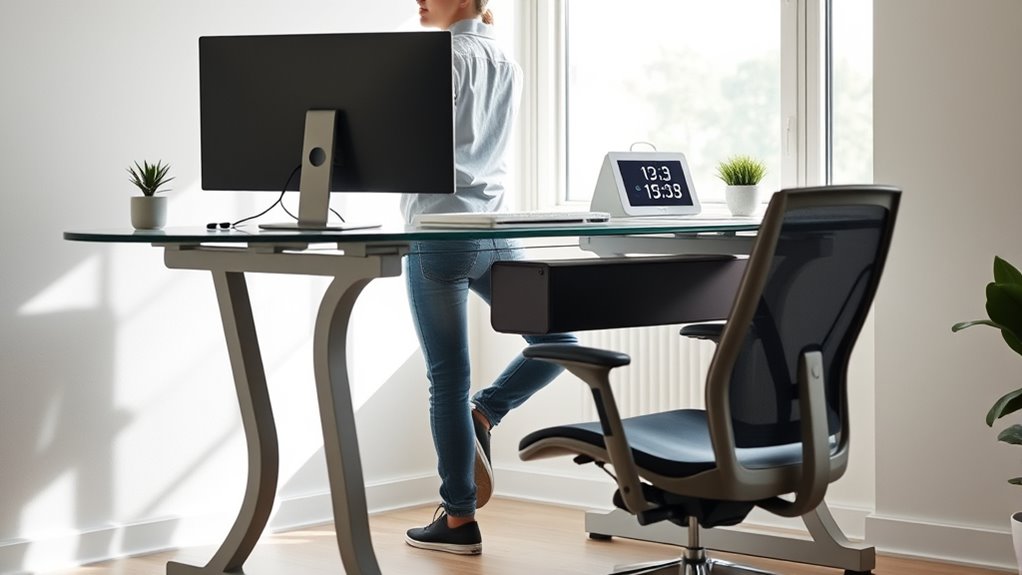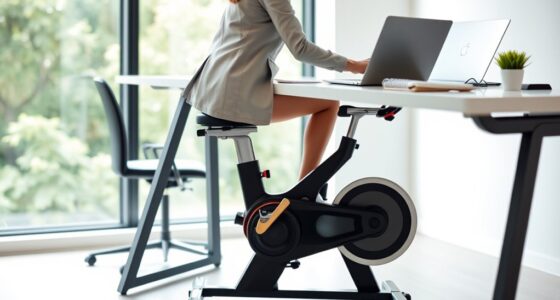To prevent burnout at your standing desk, recognize early signs like fatigue, irritability, or discomfort. Create a work schedule with 25 to 50-minute focused intervals, interspersed with active breaks involving stretching or walking. Use ergonomic accessories and adjust your setup for comfort. Regularly tweak your routine based on how your body responds. Keep exploring ways to optimize your workspace and habits for lasting comfort and productivity.
Key Takeaways
- Establish work intervals of 25-50 minutes with regular short breaks to prevent fatigue and support mental focus.
- Incorporate active recovery, like stretching and light movement, during breaks to reduce muscle stiffness and boost circulation.
- Use ergonomic accessories and workspace adjustments to maintain proper posture and reduce physical stress.
- Utilize scheduling tools and reminders to ensure consistent standing and sitting periods are balanced throughout the day.
- Regularly assess your comfort and modify your routine to prevent burnout and sustain long-term productivity.
Recognizing the Signs of Burnout

Burnout often sneaks up on you, making it harder to notice until it’s already affecting your well-being. You might feel exhausted, both physically and mentally, even if you’ve had enough sleep. Pay attention to changes in your mental health—persistent irritability, difficulty concentrating, or feelings of overwhelm are red flags. An ergonomic setup can also contribute; if your workspace isn’t supporting good posture, you may experience ongoing discomfort that adds to your stress. Recognizing these signs early helps you take action before burnout worsens. It’s essential to listen to your body and mind, acknowledging when you need a break. Staying aware of these signs keeps you proactive, ensuring your work routine doesn’t drain your energy or compromise your health. Incorporating regular breaks and managing workload are key strategies in preventing work-related burnout.
Designing an Effective Work and Break Cycle

Have you established a balanced work and break schedule that keeps your energy levels steady? To do this, plan work intervals around your natural focus spans—usually 25 to 50 minutes—and include short breaks to prevent fatigue. During breaks, focus on posture correction exercises, like gentle stretches, to counteract the effects of prolonged standing or sitting. Use ergonomic accessories, such as adjustable monitor arms or cushioned mats, to support proper alignment during work sessions. Incorporating regular, intentional breaks helps reset your muscles and mind, reducing burnout. Avoid staying in one position for too long; instead, alternate between standing and sitting with the right tools. Implementing projector calibration techniques can further optimize your workspace for comfort and productivity. This smart cycle of work and rest will improve your comfort and productivity while safeguarding your health.
Incorporating Active Recovery Into Your Day
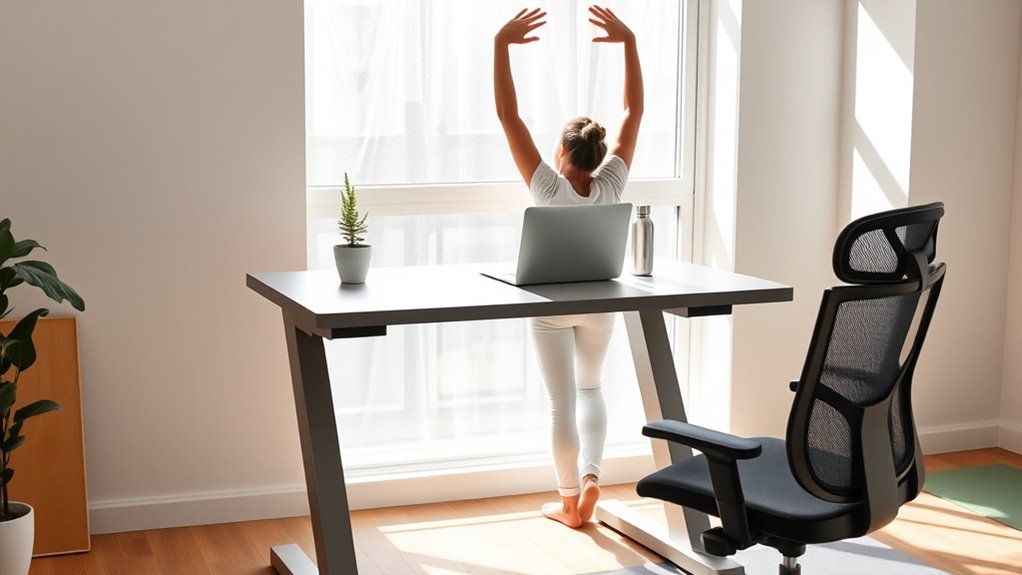
Building on your balanced work and break routines, incorporating active recovery into your day can further boost your energy and prevent fatigue. Try simple stretching routines during breaks to loosen tight muscles and improve circulation. Focus on neck, shoulder, and back stretches to counteract the effects of prolonged standing or sitting. Don’t forget hydration habits—drinking water regularly helps keep your muscles flexible and your mind alert. Active recovery doesn’t need to be intense; even light movements like walking around or gentle stretching can refresh your body. Incorporating proper ergonomic practices can enhance the benefits of active recovery by supporting correct posture and reducing strain. These small, intentional activities enhance circulation, reduce stiffness, and support overall well-being. By integrating active recovery into your schedule, you’ll maintain energy levels and stay productive without risking burnout.
Tools and Techniques for Staying on Track
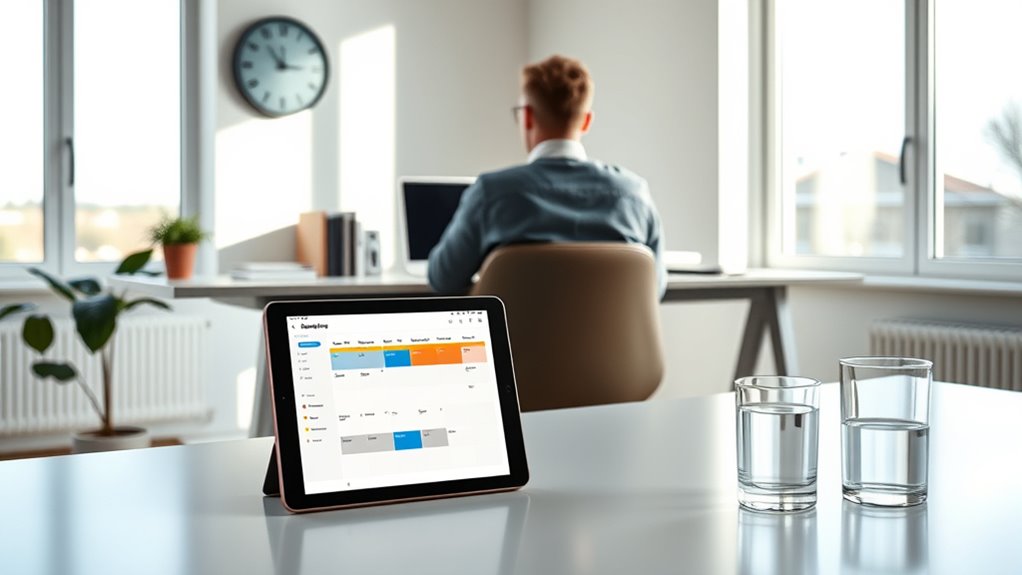
Staying on track with your standing desk routine requires effective tools and techniques that promote consistency and focus. Ergonomic accessories like adjustable footrests, anti-fatigue mats, and monitor stands help maintain proper posture, reducing discomfort and fatigue. These accessories make it easier to stand comfortably and sustain your routine longer. Additionally, productivity apps serve as valuable tools to schedule breaks, set reminders, and track your standing time. By integrating these apps into your daily routine, you stay mindful of your standing intervals and prevent burnout. Incorporating Mazda Tuning concepts such as ergonomic adjustments and performance optimization can inspire innovative ways to enhance your workspace setup. Combining ergonomic accessories with smart scheduling through productivity apps creates a seamless system that encourages healthy habits. This approach keeps you energized, focused, and committed to balancing standing and sitting, ultimately supporting your well-being.
Adjusting Your Schedule for Long-Term Success
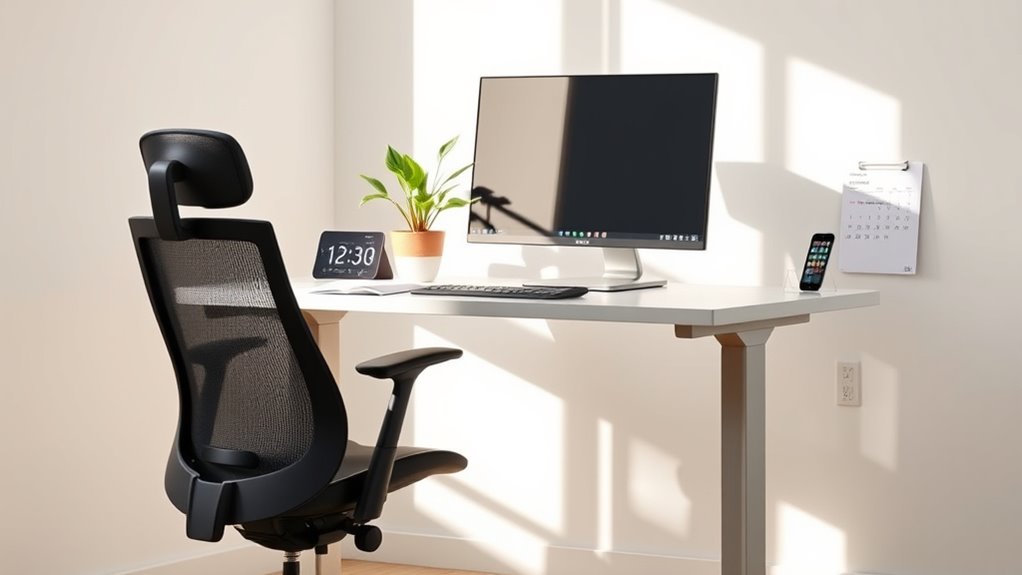
To guarantee your standing desk routine remains sustainable over time, it’s essential to regularly adjust your schedule based on your body’s responses and changing needs. Incorporate ergonomic tips to improve comfort, such as adjusting your desk height and adding anti-fatigue mats. Pay attention to signs of fatigue or discomfort and modify your standing and sitting intervals accordingly. Good workspace organization also plays a key role—keep essentials within reach and maintain proper posture to prevent strain. Regularly reevaluating your schedule ensures you avoid burnout and maintain productivity. Remember, flexibility is key; what worked initially might need tweaking as your body adapts. Additionally, being aware of expiration of vape juice and signs of spoiled products can help you maintain a safe environment while working long hours. By staying attentive and making incremental adjustments, you set yourself up for long-term success while keeping your standing desk experience comfortable and sustainable.
Frequently Asked Questions
How Can I Prevent Burnout Before It Starts?
To prevent burnout before it starts, you should prioritize good time management and incorporate regular breaks into your routine. Avoid overloading your schedule and set clear boundaries between work and rest. Practice stress reduction techniques like deep breathing or quick walks. By managing your workload wisely and taking time for self-care, you’ll stay energized and focused, reducing the risk of burnout before it even begins.
What Are Quick Mental Breaks to Boost Productivity?
To boost productivity with quick mental breaks, try mindful breathing exercises, taking a minute to focus on your breath to clear your mind. You can also do a mental puzzle, like a quick word game or riddle, to engage your brain differently. These small breaks help reset your focus, reduce stress, and prevent burnout. Incorporate them regularly to keep your energy levels high and your mind sharp throughout the day.
How Does Ergonomic Setup Influence Burnout Risk?
Your ergonomic setup plays a key role in preventing burnout. When you focus on posture awareness and make sure your equipment ergonomics are correct, you reduce physical strain and discomfort. Properly adjusted chairs, monitors at eye level, and supportive accessories promote good posture, helping you stay energized and avoid fatigue. By prioritizing ergonomic setup, you minimize the risk of burnout caused by ongoing physical tension and discomfort during long work hours.
Can Dietary Habits Impact Energy Levels During Work?
Did you know that proper hydration can boost your energy by up to 14%? Your dietary habits, like nutritional timing and hydration strategies, directly impact your energy levels during work. Eating balanced meals at regular intervals keeps your blood sugar steady, preventing crashes. Staying hydrated with water or herbal teas helps maintain focus and stamina. By optimizing these habits, you can stay energized and productive throughout your workday.
How Do Social Interactions Affect Recovery From Burnout?
Social interactions play a vital role in your recovery from burnout by providing social support and boosting emotional resilience. When you connect with others, you share your feelings and gain encouragement, which helps reduce stress and restore motivation. These positive interactions strengthen your mental well-being, making it easier to bounce back. Prioritizing meaningful social connections can accelerate your recovery and improve your overall resilience against future burnout.
Conclusion
Remember, finding balance is like tending a delicate garden—you need to water your plants regularly and give them time to grow. By recognizing burnout signs and designing smart schedules, you’re nurturing your well-being rather than letting stress choke your progress. With active recovery and the right tools, you’ll keep your energy blooming. So, steer your day with intention, and watch your productivity flourish like a well-tended garden in full bloom.
